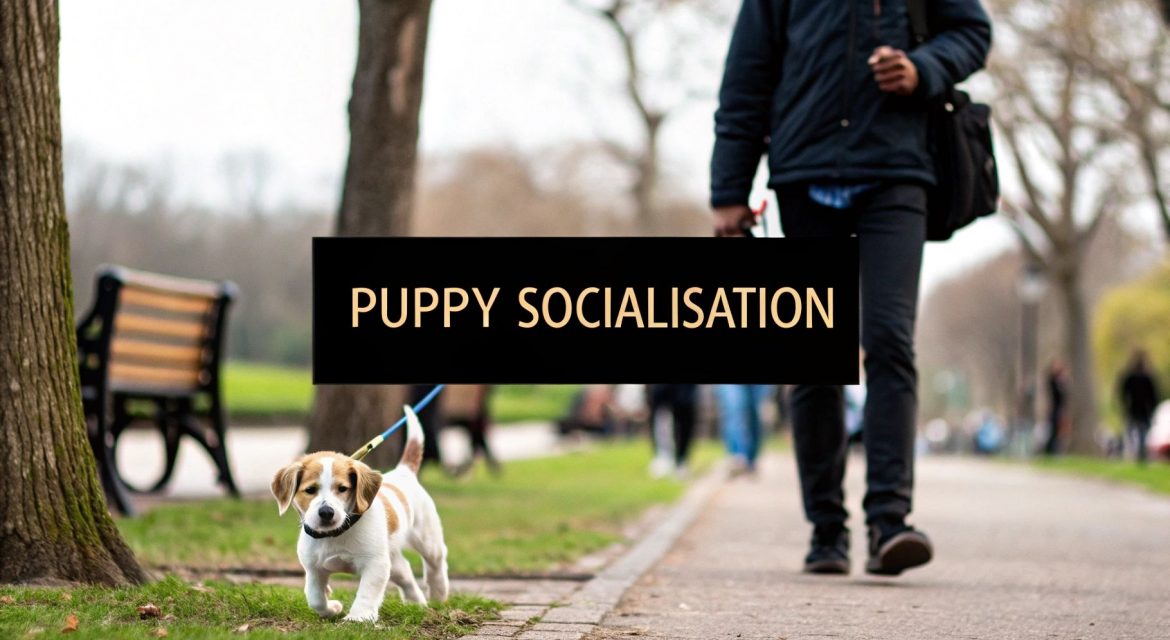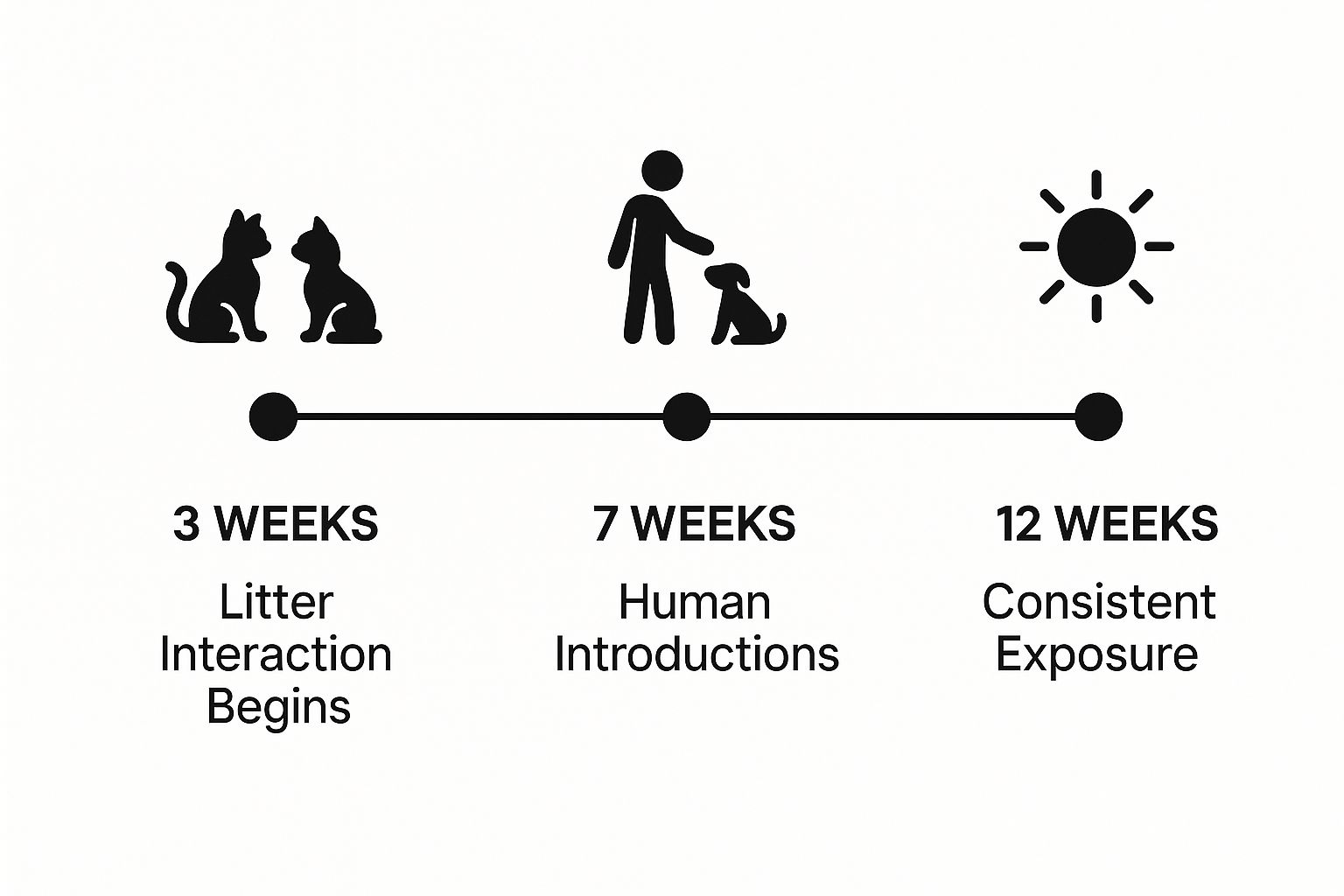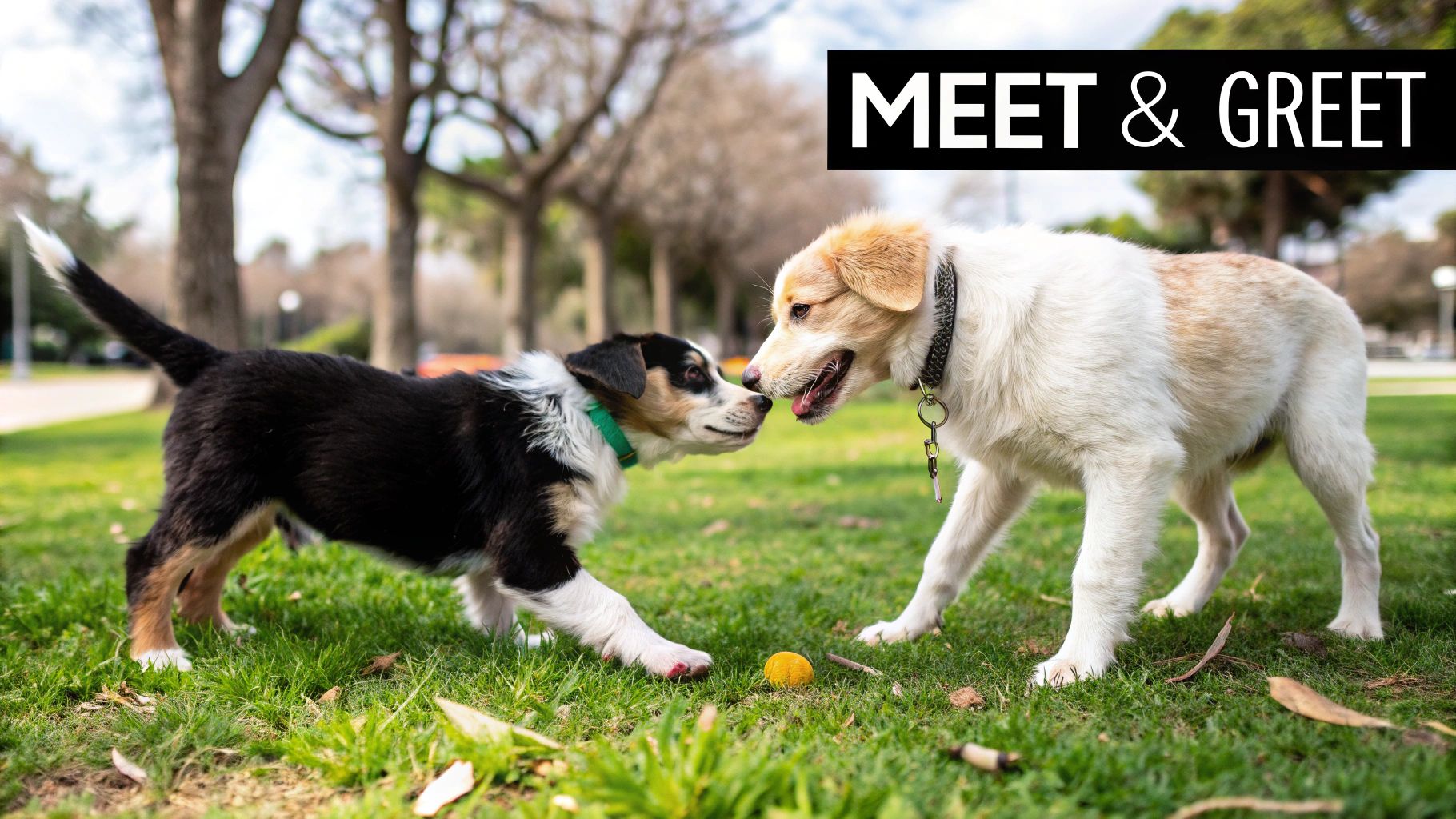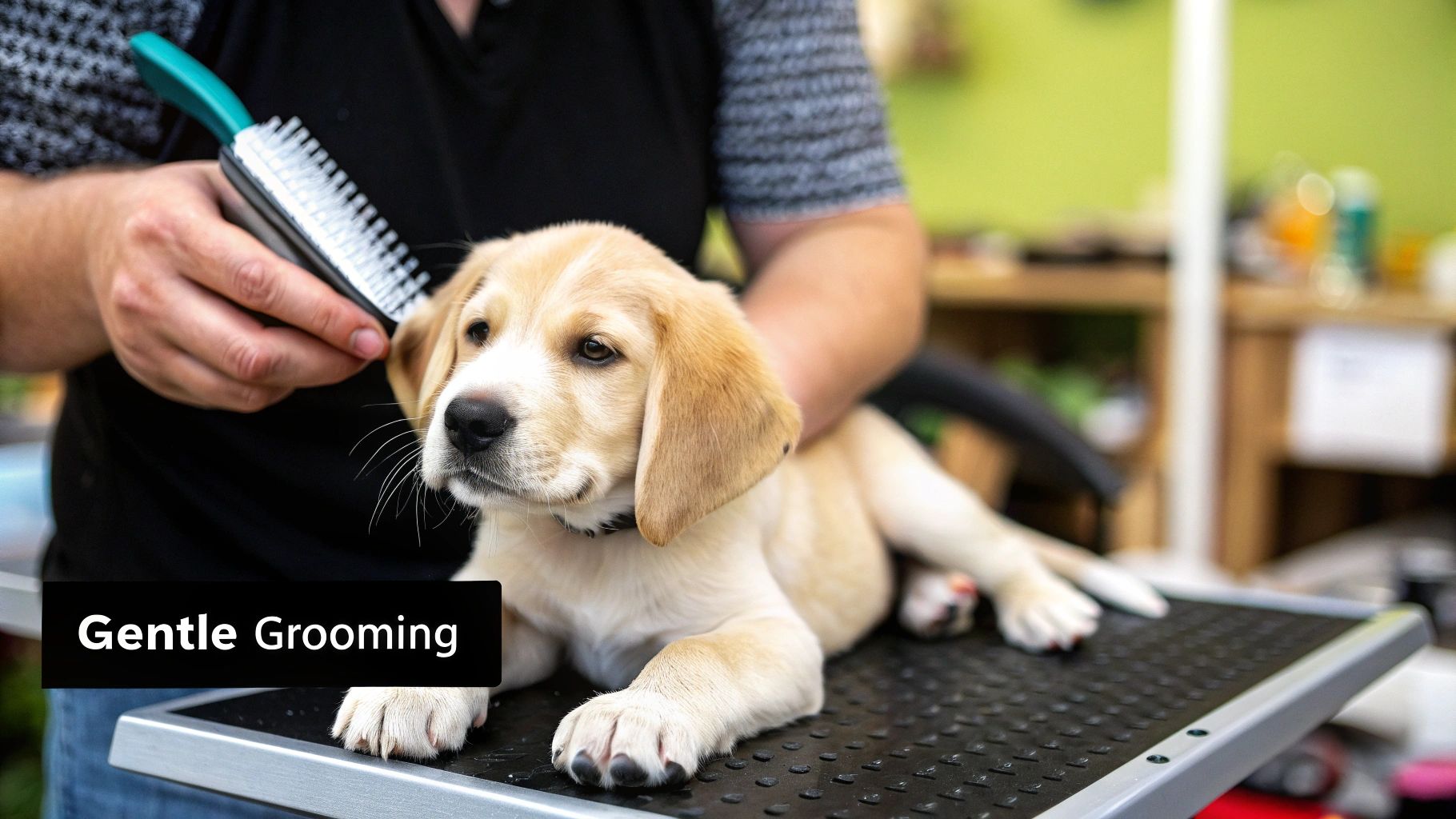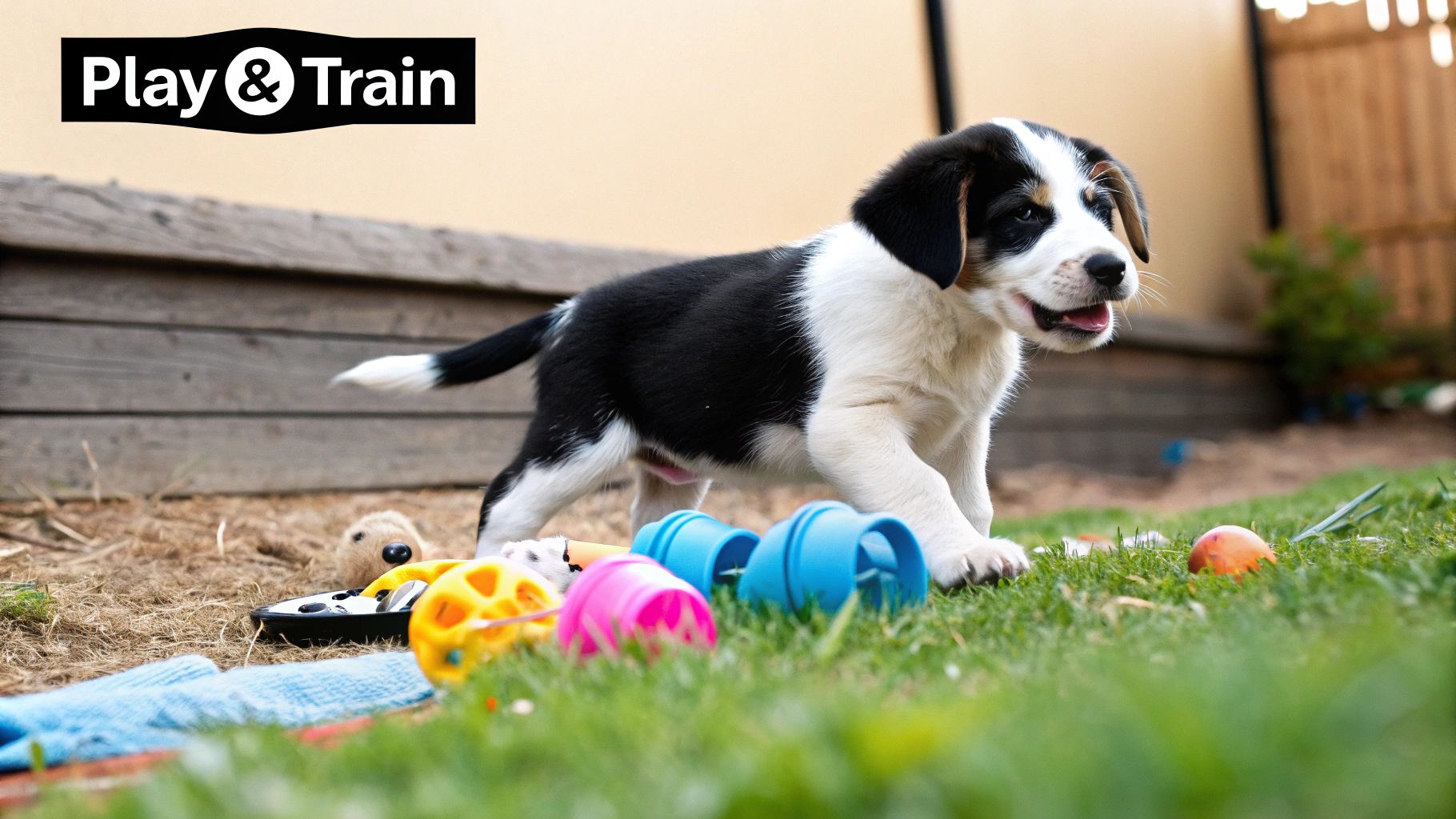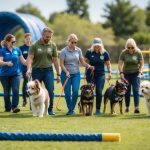Bringing a new puppy home is one of life's greatest joys! As we settle into this exciting new chapter, one of the most valuable things you can do for your furry friend is to guide them through proper socialization. This isn't just about playdates; it's about us building a foundation for a confident, well-behaved adult dog, together.
Our goal isn't to throw your pup into the deep end with a flood of new experiences all at once. Far from it. Think of it as us carefully curating a library of positive memories they can draw upon for the rest of their life. It’s a process of gentle, controlled introductions to the world in all its wonderful variety.
Why Your Puppy's First Weeks Matter Most
So, what's all the fuss about the first few weeks? Well, there's a crucial window for socialization that happens between 3 and 16 weeks of age. This is when your puppy's brain is like a sponge, soaking up information about what's safe and what's not.
For most of us UK owners, who typically bring our puppies home around 8 weeks, this window feels even shorter. We've got a limited time to make a massive impact. It’s all about quality over quantity. Every positive, happy encounter helps build their resilience and prevents behavioral issues down the road.
This timeline gives you a great visual guide to your puppy's early development and socialization journey.
As you can see, it starts with their littermates and mother, but once they're with you, the focus shifts to human introductions and exploring the big wide world.
To help you keep track, here's a quick-reference table outlining the key socialization stages.
Your Puppy's Socialization Timeline (3-16 Weeks)
This table breaks down the key developmental windows and gives you some practical ideas for each stage.
| Age Window | Key Focus | Example Activities |
|---|---|---|
| 3-8 Weeks | Canine Socialization & Human Handling: Learning bite inhibition from littermates and becoming comfortable with gentle human touch from the breeder. | Playing with siblings, being handled gently by the breeder's family, initial exposure to household sounds. |
| 8-12 Weeks | Fear Impact Period & Human Socialization: Forming lasting impressions. Positive experiences are crucial, and scary ones can have a long-term impact. | Meeting vaccinated, calm adult dogs. Experiencing different surfaces (grass, pavement, carpet). Hearing the hoover from a distance. |
| 12-16 Weeks | Exploring the World & Confidence Building: Expanding their horizons post-vaccinations. Building on earlier experiences to create a well-rounded dog. | Short, supervised walks in different places (quiet parks, pet-friendly shop car parks). Meeting a variety of people (different ages, appearances). |
Remember, this timeline is a guide. Always watch your puppy's body language and go at their pace.
Key Things to Focus On
So, what should we actually do? The most important thing is to keep it positive. We want every new experience to be a good one.
Here are a few core areas to work on together:
- Gentle Handling: Get your puppy used to you touching their paws, looking in their ears, and checking their tail. Do it calmly and for short periods, always followed by praise or a treat. This makes future vet visits so much easier for both of you!
- Household Noises: Don't tiptoe around! Let them hear the hoover, the washing machine, and the TV, but start from a distance. Let them investigate on their own terms and reward them for being brave.
- New People and Places: Let's arrange for them to meet new friends and see new sights, but always from a safe and controlled setting. We'll start small – a quiet visit from a friend is so much better than a huge party.
Having a predictable routine and a safe haven is also vital. A comfy bed or a crate can act as their personal den, a secure spot they can retreat to if they feel overwhelmed. For more tips on this, our guide on how to crate train a puppy is a great place to start.
Right, before we even dream of that first exciting trip to the park, the real work begins at home. This is where we lay the groundwork for a confident, well-adjusted dog. Think of your house as a safe little training bubble, with you as your puppy's trusted guide. Our job is to show them that the world, starting with their own four walls, is interesting and, most importantly, nothing to be scared of.
It’s all about turning potentially frightening things into complete non-events. We want to gently introduce them to the everyday sights and sounds of a home. Put yourself in their paws for a moment: that giant, roaring machine (the hoover) or a sudden, piercing chime (the doorbell) can be genuinely terrifying.
Turning Scary Sounds into Happy Noises
The trick here is to control the intensity of the sound and build a positive connection. Don't just wait for an unexpected delivery to set the doorbell off. Instead, let's get proactive.
- Ask a friend or family member to pop outside.
- Have them ring the doorbell just once – softly, if your doorbell allows it.
- The very second the chime sounds, casually toss a super tasty, high-value treat on the floor for your puppy.
Do this a few times, and you'll see the magic happen. Your puppy will quickly figure out that the doorbell sound actually predicts that something delicious is about to appear. You can apply this exact same logic to the hoover. Start with it switched off in the room, letting your pup have a good sniff. Later, switch it on in a distant room while they're busy with a fun chew toy. Over a few days, you can slowly bring it closer. The goal is always the same: scary noise = fantastic treat.
We're doing more than just getting them used to noise; we're actively teaching them that these sounds are a cue for good things. This simple shift in their mindset is what builds a truly brave, resilient dog.
Establishing Trust Through Handling
Just as vital as sounds is getting your puppy comfortable with being touched and handled all over. Nailing this now will make future vet visits and grooming appointments a thousand times less stressful for both of you.
Start with very brief, gentle sessions when your puppy is already calm and relaxed. Lightly touch a paw, take a quick peek inside an ear, or lift their lip to glance at their teeth. Follow every single touch, no matter how brief, with immediate praise and a tiny treat. You want them to connect your handling with good feelings, not with being restrained or scared.
- Paws: Gently touch and hold each paw for just a second.
- Ears: Briefly lift the ear flap and look inside.
- Mouth: Softly lift their lip to see their teeth.
Keep these interactions incredibly short – we're talking a few seconds at first. If your puppy pulls away, you've moved a bit too fast. No big deal. Just end on a positive note and try again later with an even lighter, quicker touch. Every single positive interaction is another drop in the bucket of trust you're building together.
Making Positive First Impressions with People
Introducing your puppy to new people is one of the most exciting parts of being a new pet parent! But as their trusted guide, it’s our job to manage these greetings so they feel safe and fun, not frightening. We want to teach our pups that humans—in all their wonderful shapes and sizes—are a source of pleasant experiences, not stress or over-excitement.
This process is all about quality over quantity. A few calm, positive encounters are far more valuable than dozens of chaotic ones. The key is for us to keep our puppies feeling secure, allowing them to approach new people at their own pace.
Setting the Scene for Success
The best introductions happen in controlled environments where you call the shots. Your home or a quiet, familiar outdoor space is perfect. Before introducing a new friend, it helps to give your puppy a chance to burn off a little energy with a quick play session.
Always arm your guest with a few high-value treats before they even say hello. Instruct them to completely ignore the puppy at first—no direct eye contact, no reaching, and no talking to them. This simple approach takes all the pressure off and lets your puppy’s natural curiosity take over.
When your pup inevitably goes to investigate, your guest can casually drop a treat on the floor. This small action teaches your pup that good things happen when new people are around.
The goal is for your puppy to make the choice to engage. By letting them initiate contact, you empower them and build their confidence in social situations. They learn that they are in control, which reduces the chance of fear-based reactions.
Becoming Your Puppy’s Best Advocate
Out in the real world, you can’t always control the environment. Well-meaning strangers will often rush towards your adorable pup, arms outstretched. This is where you need to step in and become their advocate. It's perfectly okay to say, “He’s in training, so could you please let him come to you?”
Here are a few common scenarios and how to handle them:
- The Enthusiastic Stranger: If someone approaches too quickly, use your body to create a gentle physical barrier. Step in front of your puppy and politely ask the person for some space.
- Meeting Children: Teach children to be calm and gentle. Show them how to offer a treat with an open palm or simply let the puppy sniff the back of their hand. Always supervise these interactions closely.
- People with Hats or Bags: Objects can be scary! Introduce these things from a distance first. Have a friend wearing a hat stand far away, tossing treats towards your pup, and gradually decrease the distance as they get comfortable.
Learning to interpret your puppy's signals is essential for knowing when they're happy or stressed. Our detailed guide on how dogs communicate with people can help you become fluent in their language.
The recent surge in pet ownership means more puppies than ever need our help. The COVID-19 pandemic saw around 3.2 million UK households get a new pet. With 17% of families finding puppy training harder than they expected, the need for proper socialisation guidance has never been greater. Your dedication to positive socialisation helps set these pups up for a happy, confident life.
Helping your puppy learn to ‘speak dog’ is one of the most important lessons we can teach them. It’s all about building their confidence so they can communicate politely with their own kind. This is where you, as their trusted human, play a huge role in setting up successful and safe introductions to other dogs.
It’s tempting to round up every dog you can find for your puppy to meet, but successful socialization is about quality, not quantity. A handful of positive, controlled playdates are infinitely more valuable than one chaotic free-for-all at the park.
Choosing the Right Canine Tutors
Not all dogs are cut out to be good teachers for a young, impressionable puppy. Our mission is to find canine role models: dogs who are calm, well-socialized, and fully vaccinated. An older, patient adult dog can be the perfect mentor, gently teaching your pup appropriate play boundaries and communication signals.
Your puppy's first few interactions with other dogs will set the stage for their future attitudes. A positive experience builds confidence; a negative one can install fear that lasts a lifetime.
Think of it like choosing a babysitter for your child. You wouldn't pick someone random; you'd want a person who is calm, kind, and trustworthy. We should apply the same careful consideration when selecting playmates for our puppies.
Reading the Room and Their Body Language
Learning to read dog body language—both your puppy's and the other dog's—is your superpower. Knowing when to step in is just as important as knowing when to let them sort things out themselves.
Look for the good stuff, the signs of happy, relaxed play:
- Play Bows: The classic "front end down, bum in the air" invitation to have some fun.
- Soft Bodies: Loose, wiggly movements, not stiff, tense postures.
- Taking Turns: Watch for them to switch roles, where one chases and then the other takes over.
- Sneezing: It might sound odd, but it's often a sign that a dog is just playing and not being serious.
On the other hand, if you spot a tucked tail, flattened ears, or see your puppy trying to hide, it’s time to calmly intervene. Create some space and end the interaction on a positive note. That's always the best strategy.
The responsibility for this early canine education is significant. With over 10 million pet dogs in the UK, proper socialisation is a cornerstone of responsible ownership. While UK commercial breeders are legally required to provide socialisation, the lack of specific guidelines means experiences can vary wildly. This, combined with factors like the 'Pandemic Puppies' phenomenon, has been linked to a rise in behavioural issues, making your efforts even more crucial. You can read more about these findings on puppy socialisation and understand why structured programmes are so important.
Picking the right playdate for your puppy can feel a bit daunting. To help you spot the difference between a great socialisation opportunity and a potentially risky one, here’s a quick comparison.
Good vs. Risky Puppy Playdates
| Characteristic | Good Playdate (Green Flag) | Risky Playdate (Red Flag) |
|---|---|---|
| The Other Dog | A known, calm, and patient adult dog that is fully vaccinated. | An unknown dog with an unpredictable temperament or a boisterous, untrained one. |
| Environment | A quiet, neutral space like a secure garden. | A busy, uncontrolled public park or a chaotic environment with too many dogs. |
| Supervision | Both owners are actively watching the dogs and their body language. | Owners are distracted, on their phones, or believe in letting the dogs "sort it out" no matter what. |
| Play Style | Gentle, reciprocal play with breaks. Dogs are taking turns chasing and being chased. | Overly rough, one-sided play. One dog is constantly pinning or bullying the other. |
| Puppy's Reaction | Puppy seems happy, engaged, and keeps going back for more. | Puppy is trying to hide, yelping, has its tail tucked, or is showing other signs of fear. |
Using this as a guide can help you ensure your puppy's experiences are building confidence, not creating fear.
The Value of a Good Puppy Class
Well-run puppy classes are a fantastic way to handle socialization in a safe, structured environment. A good class will always prioritize positive reinforcement and have dedicated, supervised off-lead play sessions. It’s a controlled space where your puppy can meet others of a similar age and learn from a qualified professional.
When you're looking for a class, don't be shy. Ask the trainer how they manage play sessions and make sure the groups are kept small. This investment in their early education will pay dividends, helping you raise a dog that is comfortable and confident around its own species.
Exploring the World One Paw at a Time
That great big world beyond your front door? For a new puppy, it’s a whirlwind of fascinating new sounds, smells, and surfaces. Our job is to be their personal tour guide, making sure every new adventure feels exciting and safe, not overwhelming. This whole process is about building a confident, resilient dog who can take new situations in their stride.
It all comes down to gradual exposure and always, always keeping a close eye on your puppy for any signs of stress. Every small, positive experience is another brick in the foundation of a well-adjusted, happy adult dog. You’re teaching them that the world is a fun place to be, especially with you by their side.
A World of Textures and Sounds
Take a moment to think about all the different things your puppy will walk on throughout their life. Your house probably has familiar carpets or wooden floors, but the great outdoors is a whole new ball game. We want to make sure these new textures are no big deal.
You can easily turn this into a fun game. During your outings, gently guide them over different surfaces like:
- Lush green grass
- Cool, smooth pavement
- Crunchy gravel or woodchips
- Slightly damp soil after a bit of rain
Let them have a good sniff and take their time exploring. When they show curiosity, reward them with plenty of praise. The same idea applies to sounds. We don’t need to march them down a busy high street straight away. Start small. Just sitting on a quiet park bench lets the world go by. From the safety of your lap or a lead, they can hear distant traffic, children laughing, and birds chirping.
Adventures Before Vaccinations Are Complete
One of the most common worries I hear is about socializing a puppy before they're fully vaccinated. The secret is to let them explore without their paws ever touching public ground where unvaccinated dogs might have been. This is where you get to be a bit creative!
Carrying your puppy is a brilliant way to introduce them to new environments safely. A short trip to a pet-friendly café, where they can sit on your lap and just watch the world go by, is an incredible experience for them. They get to soak in all those new smells and sounds from a completely secure vantage point.
By managing their environment this way, you're not pausing their education. You're giving them a safe 'front-row seat' to the world, building positive associations long before they take their first proper walk.
Of course, sometimes new experiences can be a little much and lead to an upset tummy. If you notice any issues like car sickness on these little trips, it’s really helpful to know how to stop a dog from being sick so you can keep them comfortable on your adventures together.
Your Puppy Socialisation Checklist
To help you get started, here’s a little checklist for environmental exposure. The aim isn't to tick everything off in a week, but to gently introduce these experiences over time, always at your puppy's pace.
Sights:
- People wearing hats or glasses
- People on bicycles or skateboards (from a safe distance!)
- Prams and shopping trolleys
- Buses and cars driving past
Sounds:
- A distant siren
- A car door slamming nearby
- Different types of music playing
Locations:
- Sitting quietly outside a shop
- A short, happy trip in the car (even just around the block)
- Visiting a friend's secure garden
Remember, every single puppy is an individual. One might not bat an eyelid at traffic noise, while another might need more time and distance to feel comfortable. Read their body language, keep every interaction positive, and celebrate every tiny bit of progress. You're doing a fantastic job.
Your Top Puppy Socialisation Questions Answered
Even with the best-laid plans, you’re bound to have questions. It’s totally normal! We’ve gathered some of the most common queries we hear from new puppy owners who are navigating this exciting, and sometimes tricky, journey.
Think of this as a marathon, not a sprint. Every puppy and owner duo has their own rhythm, and a little reassurance along the way can make all the difference.
What if I’ve Missed the Main Socialisation Window?
This is a big worry for many: "My puppy is over 16 weeks old—have I blown it?" The short answer is a definite no. While those early weeks are a prime time for learning, socialization is a lifelong adventure. You can absolutely still teach an older puppy or adult dog to feel more confident and at ease with the world.
The approach just needs a bit of a tweak. You'll need more patience, and the process will be slower and more deliberate. Your focus remains on creating positive, controlled experiences, but you must work at your dog's pace. Never, ever force them into a situation that makes them uncomfortable. For older dogs who are particularly fearful, getting a qualified positive reinforcement trainer involved can be a game-changer.
Don't panic if you feel "behind schedule." The most important thing is to start from where your dog is right now. Focus on quality experiences that build trust between you, and you'll still make wonderful progress together.
Is the Dog Park a Good Idea for My Puppy?
For a young puppy, we generally advise against the dog park. Imagine throwing a new swimmer into the deep end of a chaotic, public pool—it can be incredibly overwhelming and unpredictable.
One bad encounter with an overly boisterous or aggressive dog can leave a lasting negative mark on your puppy's confidence. There's also a higher risk of your pup picking up illnesses before their vaccinations are fully effective.
So, what are some better alternatives?
- Curated Playdates: Set up one-on-one play sessions with a calm, friendly, and healthy adult dog that you know and trust. This is socialization at its safest.
- Professional Classes: A well-run puppy class offers a fantastic, controlled environment for socializing with other pups of a similar age and development stage.
These options give you all the benefits of social interaction without the gamble of an uncontrolled setting.
How Can I Tell if My Puppy Is Scared or Just Shy?
Learning to read your puppy’s body language is one of the most vital skills you can develop. It’s your direct line of communication, telling you when they’re feeling good versus when they’re overwhelmed.
A shy puppy might pause for a moment before cautiously investigating something new. A genuinely scared puppy, however, shows much clearer signs of stress.
Keep an eye out for these signals:
- A tucked tail, held low or clamped between their legs.
- Flattened ears, pinned back against their head.
- Yawning or lip licking when they aren't tired or hungry.
- A lowered body posture or trying to make themselves smaller.
- Actively trying to move away or hide behind you.
If you spot these signs, it's a clear signal to calmly and immediately remove your puppy from the situation. Forcing them to "face their fear" will only backfire and erode their trust in you. The goal is to always end every social outing on a high note, well before they hit their limit.
At My Life My Dog, we believe a well-socialised puppy grows into a happy, confident companion for life. Our platform is dedicated to providing you with expert guidance and support for every stage of your journey together. Explore our in-depth guides and become part of our community at https://mylifemydog.com.


